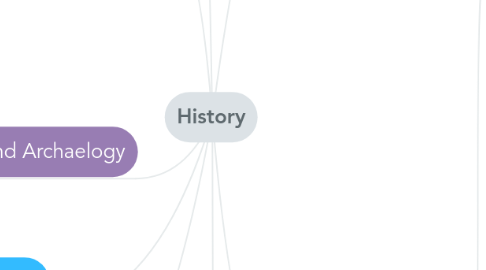
1. Meaning
1.1. Record and study of past human events
1.2. To find out
1.2.1. What happened
1.2.2. When
1.2.3. Where
1.2.4. Why
1.2.5. To whom
1.2.6. Consequences
2. Archaeology
2.1. What is it?
2.1.1. The study of objects left behind by people long ago, known as artefacts
2.1.1.1. Artefacts show how people lived when hardly any written records were made
2.2. How are artefacts found?
2.2.1. Through hearsay
2.2.2. From the air
2.2.3. By chance
2.2.4. In mounds
2.2.4.1. Mounds rise sharply above ground level but do not look like natural hills
2.2.4.1.1. Ancient cities may be buried underneath
3. Problems
3.1. Untrue or one-sided stories
3.1.1. The powerful and wealthy may only have allowed people to write the good things
3.1.2. Views of poor and less important people may not have been included
3.1.3. Some accounts might be made up for pleasure
3.2. No written records
3.2.1. Prehistoric times when no written records available
3.2.2. Archaeologists can help by finding more evidence to support a historian's writing
4. Time
4.1. Form of measurement of time to study stories from the past
4.2. Early societies
4.2.1. Seasons, floods or significant events
4.3. B.C. & A.D.
4.3.1. introduced by early Christians
4.3.2. the period before Jesus Christ's birth is referred to as B.C. ( before Christ )
4.3.3. the period after his birth is referred to as A.D. ( Anno Domini which means "In the Year of Our Lord" )
4.3.4. "circa" (about/approximately) or "c." is used where the exact date is not know.
4.4. Other ways
4.4.1. Periods
4.4.1.1. prehistory
4.4.1.1.1. before mankind learnt to read and write
4.4.1.2. divided prehistoric times based on materials used
4.4.1.2.1. Stone Age
4.4.1.2.2. Bronze Age
4.4.1.2.3. Iron Age
4.4.2. Dynasty
4.4.2.1. Time of rule of a particular dynasty
4.4.2.1.1. e.g. Qin dynasty (221 to 206 BC) refers to the period when China was ruled by the Qin emperors
4.4.3. Significant events
4.4.3.1. e.g. Scientific Revolution (1500s to 1700s)
5. History and Archaelogy
5.1. How do archaeologists help historians?
5.1.1. Archaeologists find artefacts
5.1.2. Historians gain more accurate information
5.1.3. Historians can then tell how Man progressed
6. Constructing Knowledge
6.1. Steps to forming knowledge of the past
6.1.1. Asking Questions
6.1.1.1. find out about aspects of the past
6.1.2. Gathering Sources
6.1.2.1. Studying sources to answer questions
6.1.2.2. Examine several sources to gain new details and form new explanations
6.1.2.3. Evidence to support explanations
6.1.3. Examining Sources
6.1.3.1. Find context of sources such as the situation, circumstances and reasons
6.1.3.2. Helps to understand details and come up with better inferences
6.1.3.2.1. Making inference
6.1.4. Drawing Conclusions
6.1.4.1. Support story with evidence
6.1.4.1.1. Ensure evidence is genuine
6.1.4.2. Find out the real historical facts to make story accurate
6.1.4.3. Remain unbiased while investigatimg
6.1.4.3.1. Evaluate objectively before making judgements
6.1.4.3.2. Must be based on facts rather than personal feelings
7. Why study it?
7.1. Understand change
7.1.1. Understand how our society came to be
7.1.2. All things today a products of earlier ideas
7.2. Understand the present
7.2.1. Learn about history of ancestors
7.2.2. Understand how we came to be
7.3. Understand people
7.3.1. Understand how people think and what they feel
7.3.2. Understand different beliefs and thinking
7.4. Questioning
7.4.1. Judging the accuracy of what we read and hear
7.4.2. An event or person may be written in many different ways
7.4.2.1. Look for explanations for the difference
7.5. Critical thinking
7.5.1. Put together pieces of information
7.5.2. Ask questions and look for evidence to support claims
7.6. Learn lessons
7.6.1. Understand why certain events happened and their effects, allowing us to prevent it
7.6.1.1. e.g. Titanic and it's sinking
7.6.2. Learn from outstanding people with great influence on people
7.6.2.1. e.g. Mahatma Gandhi who freed his countrymen from British rule
7.6.3. Learn not to make the same mistakes of others
7.6.3.1. e.g. Adolf Hitler who cause the outbreak of WWII
8. How is it written?
8.1. A historian's work
8.1.1. Gathers clues and evidence
8.1.2. Selects important pieces
8.1.3. Writes an account of events, as accurate as possible
8.1.4. Accounts may be rewritten after new evidence has been found
8.2. Types of evidence
8.2.1. Oral
8.2.1.1. e.g stories, conversations and songs
8.2.2. Pictorial
8.2.2.1. e.g. paintings, old maps and photographs
8.2.3. Written
8.2.3.1. e.g. old diaries, newspapers and books
8.2.4. Material
8.2.4.1. e.g. artefacts such as ruins of buildings, coins, tools and clothings
8.2.5. Sources
8.2.5.1. collections of evidence
8.2.5.2. divided into two categories; primary and secondary
8.2.5.2.1. Primary Sources
8.2.5.2.2. Secondary Sources
8.2.5.2.3. Other sources
8.3. Evaluation
8.3.1. To check if the evidence and sources are reliable
8.3.1.1. Credibility
8.3.1.1.1. Check whether the person who gave the evidence is trustworthy
8.3.1.2. Consistency
8.3.1.2.1. Check if the statements contradict each other
8.3.1.3. Corroboration
8.3.1.3.1. Check if different sources support each other
